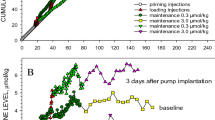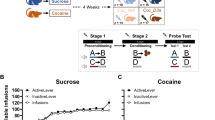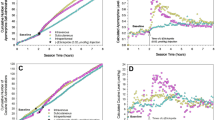Abstract
Previous studies showed that prior administration of kappa-opioid agonists decreased the development of sensitization to some of the behavioral effects of cocaine. The present study sought to determine whether the development of sensitization to cocaine's reinforcing effects was also sensitive to antagonism by kappa-opioid agonists. During a pretreatment phase, the kappa-opioid agonist, U69593 (0.0 or 0.32 mg/kg) was administered prior to (1) 2 daily injections of cocaine (0.0 or 20.0 mg/kg), or (2) cocaine or saline administered via a yoking procedure. Cocaine pretreatment decreased the latency to acquisition of cocaine self-administration. However, prior administration of U69593 during the pretreatment phase failed to attenuate the development of this sensitized response to cocaine's reinforcing effect. In other groups, the effect of acute U69593 pretreatment on the maintenance of cocaine self-administration was examined during a 10 hr session. During training and testing, a stimulus was associated with each self-administered cocaine infusion for one group whereas responding of another group was reinforced by a cocaine infusion alone. On the test day, pretreatment with U69593 (0.32 mg/kg) decreased responding during each hour of the 10 hr session for the group that was reinforced with cocaine plus the cocaine-associated stimulus. U69593 failed to produce a long-lasting disruption of cocaine self-administration for rats that were trained and tested without the cocaine-associated stimulus. These data suggest that the acquisition and maintenance of cocaine self-administration are differentially sensitive to manipulations of kappa-opioid systems. Further, the disruption of cocaine self-administration by U69593 may be due to interactions with mechanisms that underlie facilitative effects of stimuli that have been associated with self-administered cocaine infusions.
Similar content being viewed by others
Log in or create a free account to read this content
Gain free access to this article, as well as selected content from this journal and more on nature.com
or
References
Arroyo J, Markou A, Robbins TW, Everitt BJ . (1998): Acquisition and maintenance of intravenous cocaine self-administration under a second-order schedule of reinforcement in rats: Effects of conditioned cues and continuous access to cocaine. Psychopharmacology 140: 331–344
Brown EE, Fibiger HC . (1993): Differential effects of excitotoxic lesions of the amygdala on cocaine-induced conditioned locomotion and conditioned place preference. Psychopharmacology 113: 123–130
Burns LH, Robbins TW, Everitt BJ . (1993): Differential effects of excitotoxic lesions of the basolateral amygdala, ventral subiculum and medial prefrontal cortex on responding with conditioned reinforcement and locomotor activity potentiated by intraaccumbens infusions of d-amphetamine. Behav Brain Res 115: 516–528
Caine SB, Koob GF . (1994): Effects of dopamine D-1 and D-2 antagonists on cocaine self-administration under different schedules of reinforcement in the rat. J Pharmacol Exp Ther 270: 209–218
Crawford CA, McDougall SS, Bolanos CA, Hall S, Berger SP . (1995): The effects of kappa agonist U50,488 on cocaine-induced conditioned and unconditioned behavior and Fos immunoreactivity. Psychopharmacology 120: 392–399
De Wit H, Wise RA . (1977): Blockade of cocaine reinforcement in rats with the dopamine receptor blocker pimozide, but not with the noradrenergic blockers phentolamine or phenoxybenzamine. Can J Psychol 31: 195
Devine DP, Leone P, Pocock D, Wise RA . (1993): Differential involvement of ventral tegmental mu, delta and kappa opioid receptors in modulation of basal mesolimbic dopamine release: in-vivo microdialysis studies. J Pharmacol Exp Therap 266: 1236–1246
Everitt BJ, Robbins TW . (1992): Amygdala-ventral striatal interactions and reward-related processes. In Aggleton JP (ED), The Amygdala: Neurobiological Aspects of Emotion, Memory and Mental Dysfunction. New York, Wiley-Liss, pp 401–430
Everitt BJ, Morris KA, O'Brien A, Robbins TW . (1991): The basolateral amygdala-ventral striatal system and conditioned place preference: further evidence of limbic-striatal interactions underlying reward-related processes. Neuroscience 42: 1–18
Glick SD, Maisonneuve IM, Raucci J, Archer S . (1995): Kappa-opioid inhibition of morphine and cocaine self-administration in rats. Brain Res 681: 147–152
Goeders NE, Smith JE . (1983): Cortical dopaminergic involvement in cocaine reinforcement. Science 221: 773–775
Goldberg SR, Spealman RD, Kelleher RT . (1979): Enhancement of drug-seeking behavior by environmental stimuli associated with cocaine or morphine injections. Neuropharmacol 18: 1015–1017
Harmer CJ, Phillips GD . (1999): Enhanced dopamine efflux in the amygdala by a predictive, but not a non-predictive, stimulus: Facilitation by prior repeated d-amphetamine. Neuroscience 90: 119–130
Heidbreder CA, Babovic-Voksanovic D, Shoaib A, Shippenberg TS . (1995): Development of behavioral sensitization to cocaine: influence of kappa opioid receptor agonists. J Pharmacol Exp Ther 275: 150–163
Heidbreder CA, Goldberg SR, Shippenberg TS . (1993): The kappa opioid agonist U-69593 attenuates cocaine induced behavioral sensitization in the rat. Brain Res 616: 335–338
Heidbreder CA, Thompson AC, Shippenberg TS . (1996): Role of extracellular dopamine in the initiation and long-term expression of behavioral sensitization to cocaine. J Pharmacol Exp Ther 278: 490–502
Heidbreder CA, Schenk S, Partridge B, Shippenberg TS . (1998): Increased responsiveness of mesolimbic and mesostriatal dopamine neurons to cocaine following repeated administration of a selective K-opioid receptor agonist. Synapse 30: 255–262
Hitchcott PK, Harmer CJ, Phillips GD . (1997): Enhanced acquisition of discriminative approach following intra-amygdala d-amphetamine. Psychopharmacology 132: 237–246
Horger BA, Shelton K, Schenk S . (1990): Preexposure sensitizes rats to the rewarding effects of cocaine. Pharmacol Biochem Behav 37: 707–711
Horger BA, Wellman PJ, Morien A, Davies BT, Schenk S . (1991): Caffeine exposure sensitizes rats to the reinforcing effects of cocaine. NeuroReport 2: 53–56
Horger BA, Giles MK, Schenk S . (1992): Preexposure to amphetamine and nicotine predisposes rats to self-administer a low dose of cocaine. Psychopharmacology 107: 271–276
Lahti RA, Mickelson MM, McCall JM, Vonvoigtlander PF . (1985): [3H}]U-69593 a highly selective ligand for the opioid kappa receptor. Eur J Pharmacol 109: 281–284
Meil WM, See RE . (1997): Lesions of the basolateral amygdala abolish the ability of drug associated cues to reinstate responding during withdrawal from self-administered cocaine. Behav Brain Res 87: 139–148
Mello NK, Negus SS . (1998): Effects of kappa opioid agonists on cocaine- and food-maintained responding by rhesus monkeys. J Pharmacol Exp Ther 286: 812–824
Negus SS, Mello NK, Portoghese PS, Lin CE . (1997): Effects of kappa-opioids on cocaine self-administration by rhesus monkeys. J Pharmacol Exp Ther 282: 44–55
O'Dell LE, Sussman AN, Meyer KL, Neisewander JL . (1999): Behavioral effects of psychomotor stimulant infusions into amygdaloid nuclei. Neuropsychopharmacology 20: 591–602
Panlilio LV, Weiss SJ, Schindler CW . (1996): Cocaine self-administration increased by compounding discriminative stimuli. Psychopharmacology 125: 202–208
Piazza PV, Deminiere JM, Le Moal M, Simon H . (1989): Factors that predict individual vulnerability to amphetamine self-administration. Science 245: 1511
Piazza PV, Deminiere JM, Le Moal M, Simon H . (1990): Stress and pharmacologically–induced behavioral sensitization increases vulnerability to acquisition of amphetamine self-administration. Brain Res 514: 22–26
Riberdy A, Kantak KM, Spealman RD . (1995): Modulation of the discriminative stimulus effects of cocaine by the kappa-opioid agonist, U-50,488. Soc Neurosci Abs 21: 718
Rinaldi R, Roberts DCS . (1996): Initiation, maintenance and extinction of cocaine self-administration with and without conditioned reward. Psychopharmacology 128: 89–96
Robbins TW, Cador M, Taylor JR, Everitt BJ . (1989): Limbic-striatal interactions in reward-related processes. Neurosci Biobehav Rev 13: 155–162
Roberts DCS, Corcoran ME, Fibiger HC . (1977): On the role of ascending catecholamine systems in intravenous self-administration of cocaine. Pharmacol Biochem Behav 6: 615–620
Robinson TE, Berridge KC . (1993): The neural basis of drug craving: an incentive-sensitization theory of addiction. Brain Res 18: 247–291
Schenk S, Horger BA, Peltier R, Shelton K . (1991): Supersensitivity to the reinforcing effects of cocaine following 6-hydroxydopamine lesions to the medial prefrontal cortex in rats. Brain Res 543: 227–235
Schenk S, Partridge B . (2000): Sensitization to cocaine's reinforcing effects produced by various pretreatment regimens in rats. Pharmacol Biochem Behav 66: 765–770
Schenk S, Valdez A, McNamara C, House DT, Higley D, Bankson MG, Gibbs S, Horger BA . (1993): Development and expression of sensitization to cocaine's reinforcing properties: role of NMDA receptors. Psychopharmacology 111: 332–338
Schenk S, Partridge B, Shippenberg TS . (1999): U69593, a kappa opioid receptor agonist, decreases cocaine self-administration and decreases the ability of cocaine to elicit drug-seeking. Psychopharmacology 144: 339–346
Shippenberg TS, Spanagel R, Heidbreder C . (1994): Modulation of mesolimbic dopamine release by endogenous opioids: role in drug-induced sensitization and dependence. In: Louilot A, Durkin T, Spampinato U, Cador M (eds), Monitoring Molecules in Neuroscience, Proceedings of the 6th International Conference On In Vivo Methods, pp 123–125
Shippenberg TS, Heidbreder C . (1995): Sensitization to the conditioned rewarding effects of cocaine: pharmacological and temporal characteristics. J Pharmacol Exp Ther 273: 808–815
Shippenberg TS, Le Flour A, Thompson C . (1996): K-opioid agonists prevent sensitization to the conditioned rewarding effects of cocaine. J Pharmacol Exp Ther 276: 545–554
Shippenberg TS, LeFevour A, Thompson AC . (1998): Sensitization to the conditioned rewarding effects of morphine and cocaine: Differential effects of the k-opioid receptor agonist U69593. Eur J Pharmacol 345: 27–34
Spanagel R, Hertz A, Shippenberg TS . (1992): Opposing tonically active endogenous opioid systems modulate the mesolimbic dopaminergic pathway. Proc Natl Acad Sci USA 89: 2046–2050
Spealman RD, Bergman J . (1992): Modulation of the discriminative stimulus effects of cocaine by mu and kappa-opioids. J Pharmacol Exp Ther 261: 607–615
Spealman RD, Bergman J . (1994): Opioid modulation of the discriminative stimulus effects of cocaine: comparison of m, k and d agonists in squirrel monkeys discriminating low doses of cocaine. Behav Pharmacol 5: 21–31
Spencer DG, Emmett-Oglesby MW . (1985): Parallel processing strategies in the application of microcomputers to the behavioral laboratory. Behav Res Meth Instrum 17: 294–300
Taylor JR, Horger BA . (1999): Enhanced responding for conditioned reward produced by intra-accumbens amphetamine is potentiated after cocaine sensitization. Psychopharmacology 142: 31–40
Whitelaw RB, Markou A, Robbins TW, Everitt BJ . (1996): Excitotoxic lesions of the basolateral amygdala impair the acquisition of cocaine-seeking behavior under a second-order schedule of reinforcement. Psychopharmacology 127: 213–224
Acknowledgements
This research was supported by DA 10084.
Author information
Authors and Affiliations
Rights and permissions
About this article
Cite this article
Schenk, S., Partridge, B. & Shippenberg, T. Effects of the Kappa-opioid Receptor Agonist, U69593, on the Development of Sensitization and on the Maintenance of Cocaine Self-administration. Neuropsychopharmacol 24, 441–450 (2001). https://doi.org/10.1016/S0893-133X(00)00190-1
Received:
Revised:
Accepted:
Issue date:
DOI: https://doi.org/10.1016/S0893-133X(00)00190-1
Keywords
This article is cited by
-
Effects of the novel selective κ-opioid receptor agonist NP-5497-KA on morphine-induced reward-related behaviors
Scientific Reports (2023)
-
Effects of kappa opioid receptor agonists on fentanyl vs. food choice in male and female rats: contingent vs. non-contingent administration
Psychopharmacology (2021)
-
The C-2 derivatives of salvinorin A, ethoxymethyl ether Sal B and β-tetrahydropyran Sal B, have anti-cocaine properties with minimal side effects
Psychopharmacology (2017)
-
The dynorphin/κ-opioid receptor system and its role in psychiatric disorders
Cellular and Molecular Life Sciences (2012)
-
The role of the dynorphin–κ opioid system in the reinforcing effects of drugs of abuse
Psychopharmacology (2010)



